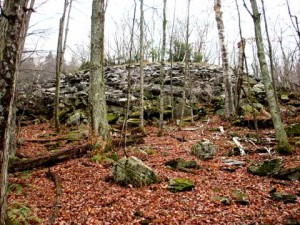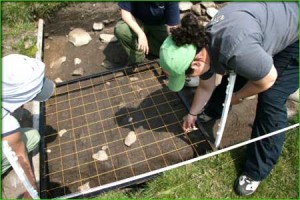When we were assigned field work as a part of archaeology class, my mind was immediately filled with images of excavations and lost artifacts. I could not have been more wrong; the only digging that occurred involved digging through the woods in order to get to the site.
We set out with one task in mind: to take a sampling unit at a previously found site in the Catskills. The Catskill Mountains are located in the Southeastern portion of the state of New York. They are home to a reservoir that supplies most of the water supply for New York City, located about 100 miles below. When New York City bought land from the Catskills to construct the reservoir, quarries were established to provide the necessary quantities of stone needed for its creation. While all of this was going on, many people were forced to leave their land. My archaeology professor, Dr. April Beisaw, is currently working on a project in the Catskills to determine how the lives of the people there were affected by all that was happening around them.
In order for us to get a taste of field work, Dr. Beisaw took us out in groups so that we could see some of what her project is all about. We drove to the Catskills, where we aimed to create a sampling unit at a site that had been previously discovered near a quarry. The goal of the sampling unit was to help us better understand what was going on at the places that had been surveyed. We found numerous types of broken glass containers, clam shells, metal fragments, metal cans, and broken dishes. Although at first these may seem like random objects, what they can tell us about the people that lived there is astounding.
If you did not know what to look for, it may seem irrelevant that there were multiple types of broken dishes, glasses, and glass containers. Everyone uses dishes, right? But when I think back to my home, I can distinctly remember having a set of matching dishes and glasses that we used on a regular basis. However, when you discover multiple dishes at one site, it begins to give you insight into the situation of the people that once lived there. Perhaps people often gave whoever lived there dishes or perhaps they could only afford mismatched items. Every find at a site can help an archaeologist learn a little more about what was really going on there.
Although people often only think of field work as excavations, there is so much more behind the term. Surveying and sampling can help an archaeologist get a better understanding of a site without ever having to break ground. Field work can include excavation, but what we set out to do was a different type of field work. We set out with goal of gaining insight into the lives of those who had once lived in the Catskills.
Works Cited:
“About the Catskills.” The Catskills Homepage. Web. 2010. <http://www.thecatskillregion.com/about-the-catskills.aspx>
Ashmore, Wendy, and Robert J. Sharer. Discovering Our Past: A Brief Introduction to Archaeology. Mountain View, CA: Mayfield Pub., 1988. Print.
Images:
http://catskillmountaineer.com/PWF-tremper.html
http://www.museumsofmayo.com/achill_1.htm
Further Reading:



The people displaced by the Ashokan reservoir, through their abandoned belongings, have become part of the archaeological record; and, according to this 2002 New York Times article, some local historians are taking notice. As author Lisa W. Foderaro notes that, in 2002, an “archaeological bounty” of the material “remnants of lives turned upside down” were uncovered in areas normally masked by the waters of the Ashokan; the unprecedentedly low water levels of that year provided a unique opportunity to examine the archaeological record of the Ashokan, and to commemorate the communities that were lost in its construction. Almost a dozen towns lay underneath the water – Ashton, Boiceville, Brown’s Station, Olive, and Shokan, to name a few – many of which acted as cultural and economic centers for the area. As larger towns were taken over by New York City for the reservoir, some of smaller towns dependent on them died as well. Even after decades and decades, tempers still run high in the Catskills, with family members of the displaced still smarting from the loss of property, loss of home, and loss of heritage, while NYC still seems “defensive” about the pain caused by the construction of the Ashokan reservoir. To read about local memorial efforts, and the ongoing tensions it attempts to mitigate, refer to the original article:
http://www.nytimes.com/2002/05/14/nyregion/watery-graves-was-no-figure-speech-receding-city-reservoir-reveals-turbulent.html
Although there was a brief period in which the receding water level of the Ashokan Reservoir exposed some artifacts that were submerged during the reservoir’s construction, due to increased water levels those artifacts are no longer within reach. Although someone can guess what type of artifacts could be found in these submerged towns, there is no way of knowing exactly what remains unless some sort of excavation was conducted. As you can see from the link provided below, many people had to leave behind their businesses as well as their homes when New York City bought land in the Catskills. In some instances, business was conducted within the homes, which would provide a very interesting archaeological study if that were possible. The people in the Catskills were unfairly compensated for their land, usually “with a payment of approximately one-half of the land’s assessed value.” The fact that the people who were displaced had to leave quickly with little money could have a large impact on what they left behind that would now be considered part of the archaeological record.
Link: http://iarchives.nysed.gov/xtf/view?docId=UCA_AshokanReservoir.xml;query=;brand=default